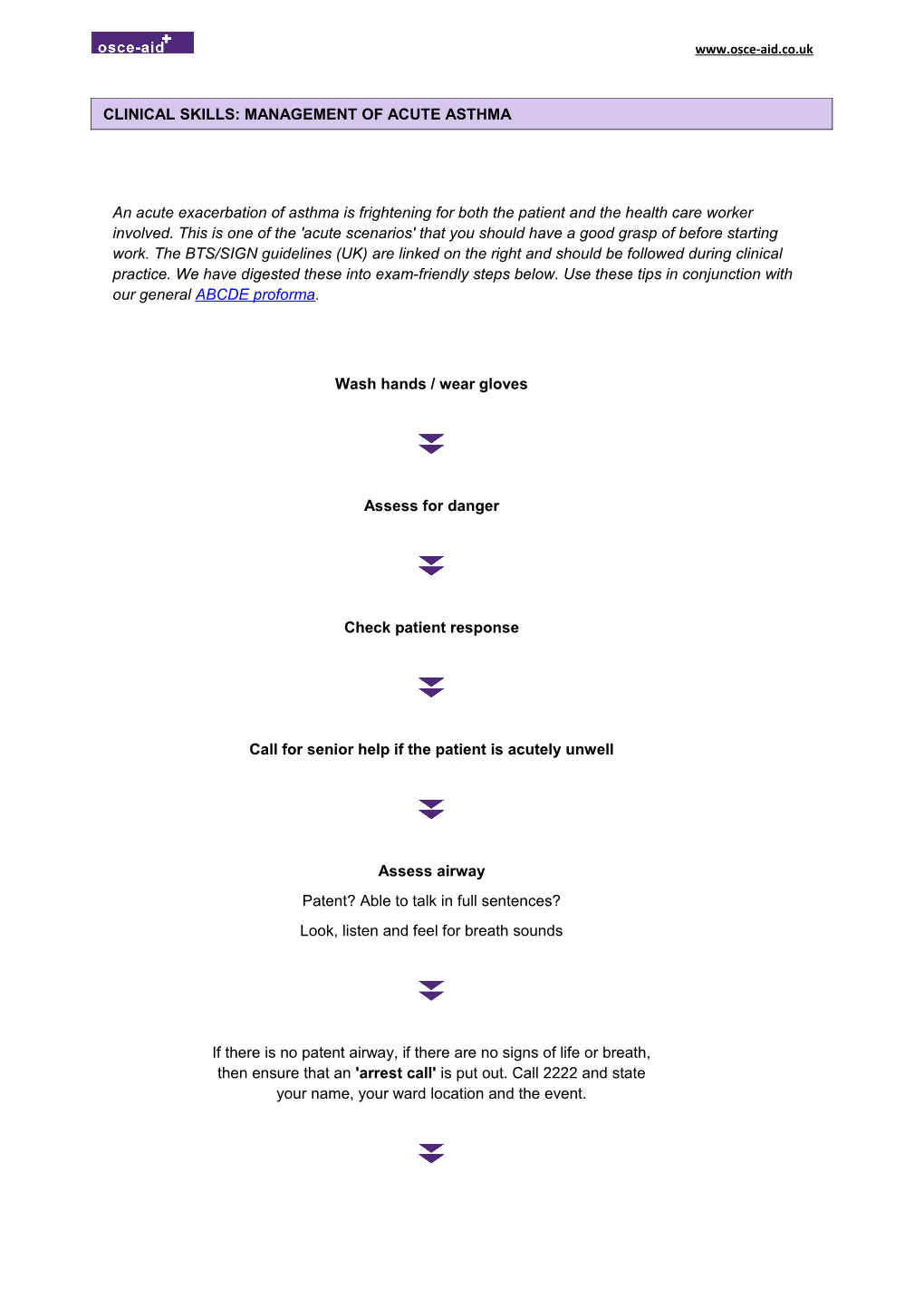An acute exacerbation of asthma is frightening for both the patient and the health care worker involved. This is one of the 'acute scenarios' that you should have a good grasp of before starting work. The BTS/SIGN guidelines (UK) are linked on the right and should be followed during clinical practice. We have digested these into exam-friendly steps below. Use these tips in conjunction with our general ABCDE proforma.
Wash hands / wear gloves
Assess for danger
Check patient response
Call for senior help if the patient is acutely unwell
Assess airway
Patent? Able to talk in full sentences?
Look, listen and feel for breath sounds
If there is no patent airway, if there are no signs of life or breath, then ensure that an 'arrest call' is put out. Call 2222 and state your name, your ward location and the event.
Assess breathing
Colour - is the patient cyanosed?
Respiratory rate - is the patient tachypnoeac or cyanosed?
Are they gasping for air, pursed lips, nasal flaring?
Are they using accessory muscles?
Listen to breath sounds with stethoscope on front and back: wheeze? "Silent Chest"?
Measure: pulse oximetry
Measure: conduct an ABG
Measure: peak flow
Order: CXR, sputum sample
Assess severity of attack (see below)
Treat - prescribe medication:
Give OXYGEN, 85%, 10-15 L/minute to aim saturations of 94-98%
Salbutamol 5mg nebulised WITH OXYGEN, repeat every 15 minutes if no improvement
Ipratropium Bromide 0.5mg nebulised WITH OXYGEN
Prednisolone 30mg-50mg PO (if cannot swallow use 100mg-200mg IV Hydrocortisone)
If patient does not respond or if "Life Threatening" features consider
- Magnesium Sulphate 1.2-2mg IV over 20 minutes
- Urgent ITU outreach referral for consideration of intubation
- Salbutamol or Aminophylline infusion could be considered in ITU
Assess Circulation
Colour
Ankle oedema
Heart sounds
Measure: capillary refill time
Measure: blood pressure
Measure: heart rate
Measure: temperature (are they septic?)
Measure: urine output
Insert 2 wide bore cannulae
Take bloods: FBC, CRP, U&Es, Blood Cultures if septic
Consider giving IV fluids
Consider antibiotics if any indicators of sepsis
Assess disability
AVPU score
Blood sugar
Expose
Examine your patient - what precipitated this exacerbation?
Do they have a respiratory tract infection?
Have they been in trauma?
Assessing Severity of Asthma
Severity / Classify according to most severe featureNear Fatal / Raised PaCO2, and/or requiring intubation and mechanical ventilation with raised inflation pressures
Life Threatening / PEFR <33% of best/predicted
Oxygen saturations <92%
PaO2 <8kPa
Normal PaCO2 (4.6-6kPa)
Silent chest
Cyanosis
Poor respiratory effort (tiring)
Arrhythmia
Exhaustion/decreased GCS
pH <7.35
Acute Severe / Unable to complete sentences
Respiratory rate >25/min
Heart rate >110/min
PEFR <50% of best or predicted
Moderate / Symptoms worse than baseline
PEFR >50-75% of best or predicted
No features of Acute Severe/Life Threatening/Near Fatal
